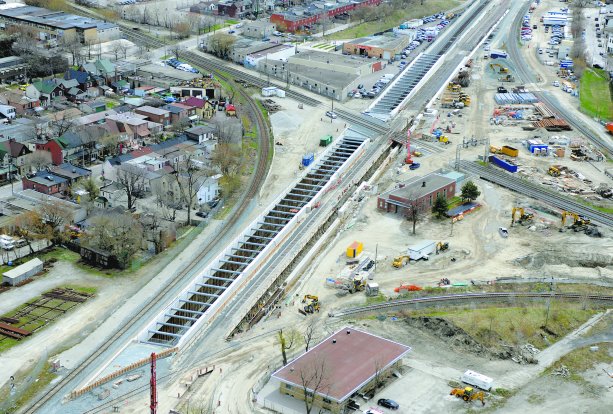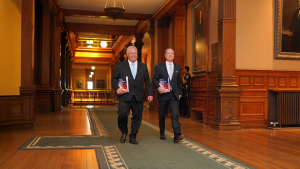After approximately eight years of construction, a major bottleneck in passenger train movement in west end Toronto was removed with the conclusion of one of the largest rail track separations in Canada.
Now, GO Transit and VIA trains travelling the Georgetown South Corridor between Toronto and Kitchener, Ont. do not have to give the right of way to CP freight trains in the former West Toronto Diamond corridor. The term diamond stems from the shape formed where double CP and double CN lines met.
For more than a century it was the busiest rail intersection in Canada.
The approximately $431-million separation involved the installation of two new bridges and two, 0.5-kilometre-long, 10-metre wide, underpasses which are nine metres deep at their deepest point. Each new underpass/lowered corridor can accommodate two sets of tracks.
A number of different contractors were involved in different phases of the separation. Preliminary site work began in 2006.
"The underpasses allow GO trains to travel below thereby bypassing freight and vehicle traffic at the two crossings," says Manuel Pedrosa, community relations manager for Metrolinx, the provincial agency tasked with the "Big Move" transit improvements in the Greater Toronto and Hamilton Area.
They were required to increase traffic on Metrolinx’s Georgetown South Corridor and to facilitate the development of the new Union Pearson Express, the dedicated rail link between Toronto’s Union Station and Pearson International Airport. Prior to the separation there was no room in the daily schedules of GO and VIA and freight services to add more trains, he says.
"Careful scheduling and innovative construction methods made the construction possible," says Pedrosa.
For example, he points to the relatively short time to install the pre-constructed bridges. They were slid into place over 24-hour time periods to minimize any impacts to CP Rail. The first bridge was installed last September and the second one at the end of June. Gascan was the general contractor for the bridge installation.
Other key firms which played a pivotal role in the West Toronto Diamond separation include: Clearway Construction, the site works general contractor; the joint venture of Anchor Shoring & Caissons Ltd and Bermingham Foundation Solutions, which installed the steel-piling foundation walls along the route; and Dufferin Construction, the pipe pile validation/excavation general contractor.
As large and complicated at it was, the separation is just one component of Metrolinx’s $1.2-billion project. It was "rolled into" the Georgetown South project when that much larger project got underway in 2010, says Pedrosa.
"By the end of 2010 shovels were in the ground."
Metrolinx is its own construction manager for the project which encompasses the construction of a number of bridges and underpasses, plus improvements to GO train stations, and other infrastructure improvements. Ten contractors and seven consulting firms serving as design consultants and/or contract administrators are involved in different phases, he says.
In 2012 Go Train service from Toronto to Georgetown was extended to Kitchener. But Metrolinx retained the original project title.
"A name change would have just been too confusing," says Pedrosa.
Each weekday, there are 16 trains operating along the Kitchener GO train line — nine operate eastbound in the morning and seven are running westbound in the evening.
There are a number of different stops and only four operate all the way from the Kitchener GO Station and Toronto’s Union Station, he says.
At some in the future, however, there will be all day service between Toronto and Kitchener and Metrolinx will be introducing off-peak trains between downtown Toronto and Brampton shortly after the project is completed.
The additional infrastructure will also allow Metrolinx to add more peak train service, says Pedrosa.











Recent Comments
comments for this post are closed